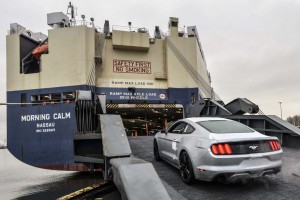
The 2015 Ford Mustang is the first of the breed to be sold globally. Sold in 100 countries around the world, a rising dollar could hurt Ford profits on the new model.
These days, it’s hard to call carmakers like Mercedes-Benz, Honda or Toyota “imports.” The vast majority of the vehicles they sell here are now produced in North America – and a fair share of the products rolling off those lines will wind up in markets abroad.
Demand for American automobiles has been growing rapidly, hitting a record 2.1 million vehicles – worth $57.5 billion – last year, according to the U.S. International Trade Administration. That was up from 1.4 million in 2005.
But even as Ford begins marketing the latest Mustang worldwide for the first time, while Tesla starts shipping Model S sedans to markets from Berlin to Beijing, there are potential storm clouds on the horizon, and they’re shaped like dollar signs.
“The U.S. dollar will rain on our exports,” Sean McAlinden, chief economist for the Center for Automotive Research in Ann Arbor, Michigan, warned USA Today.
The dollar has gained roughly 30% against the Euro since this time last year, approaching parity in recent days. That’s potentially good news for Americans looking to get a good deal on a European vacation, but it makes it a lot harder to bring tourists here – or ship U.S. goods over there.
Nonetheless, automakers are hoping that the shift in currency won’t short-circuit plans to increase automotive exports, sometime that has become an increasingly important part of their globalization plans.
Take Mercedes-Benz. Its plant near Tuscaloosa, Alabama has served as the global source for its old M-Class sport-utility vehicle – which has been redesigned for the 2016 model-year and renamed the GLE.
BMW’s plant in Spartanburg, South Carolina, serves a similar role with the big X5 sport-utility vehicle, with 70% of its production exported. All told, the German maker shipped $9.2 billion worth of U.S.-made vehicles from that factory last year, a 13% jump.
Honda last year exported 54,664 vehicles from the U.S. while importing just 37,777 vehicles from Japan. The export list ranges from the Odyssey minivan to the Acura TLX.
Tesla has made exports a major part of its business strategy going forward. But it has been slower going than the start-up expected. In China, the battery-carmaker hoped to plug into the government’s push for using electric vehicles to clean up endemic air pollution problems, but potential buyers have been wary, in part due to a lack of a charging infrastructure.
(Mustang gallops off to good start overseas. For more, Click Here.)
Ford has exported a number of vehicles over the years, though it tends to try meeting regional demand through its local plants. That approach is changing a bit as part of its One Ford strategy. In some instances, it makes more sense to focus production of specific models in one plant and then export them. The new high-performance Focus RS will come out of Europe even though the rest of the Focus line is made in the States.
Then there’s Mustang, which was long limited to the U.S. and a handful of overseas markets. The all-new, 50th anniversary Mustang is being shipped around the world, and the maker claims to be exceeding expectations in places like Europe and China.
(Click Here for more details about the ‘Stang heading to foreign lands.)
“Mustang is just one more example of the international demand for Ford cars and trucks,” Joe Hinrichs, Ford’s president of the Americas, said in January, when the first boatload of pony cars set sail for China. “The success of our One Ford plan presents opportunities for growth in global markets.”
According to industry and government figures, about 18% of U.S.-made vehicles were exported last year. Meanwhile, when adding in parts and components, the value of those auto exports jumped to $159.5 billion last year, up 4.5% from 2013.
(To see how Ford and GM are focused on foreign markets, Click Here.)
Whether the rise in the value of the dollar will scuttle the upward export trend remains to be seen but there are clear concerns by industry leaders that it could become more difficult going forward.
